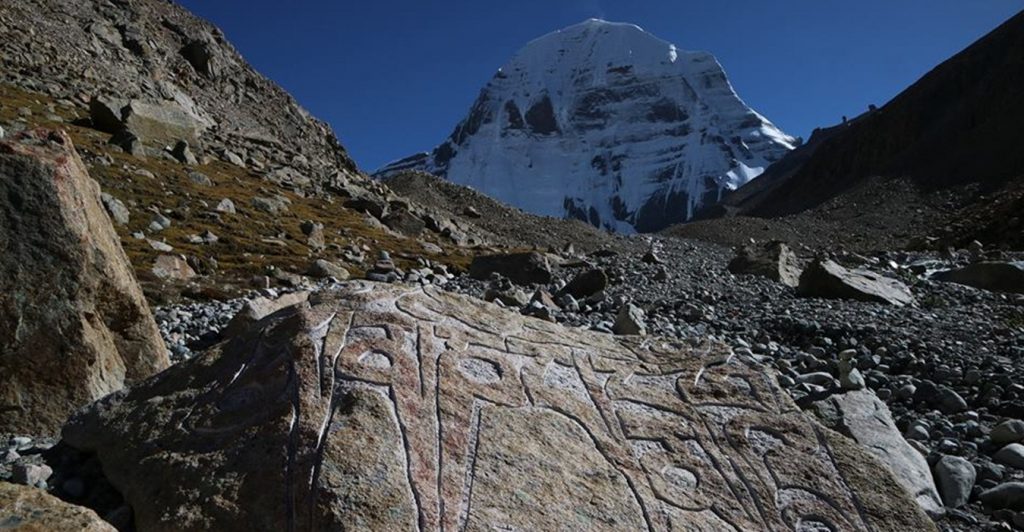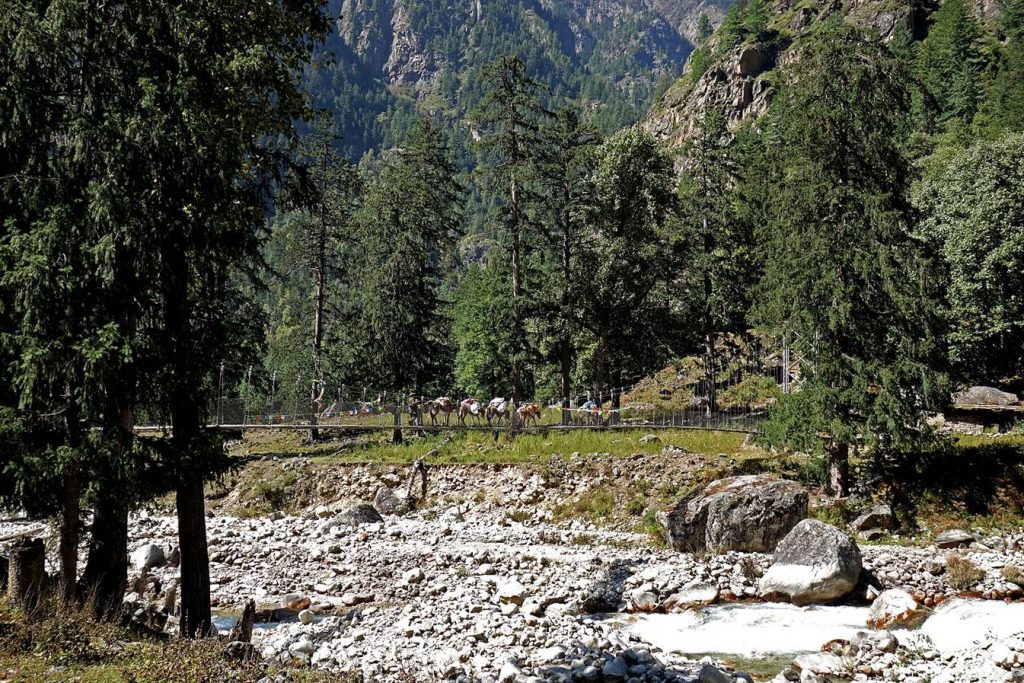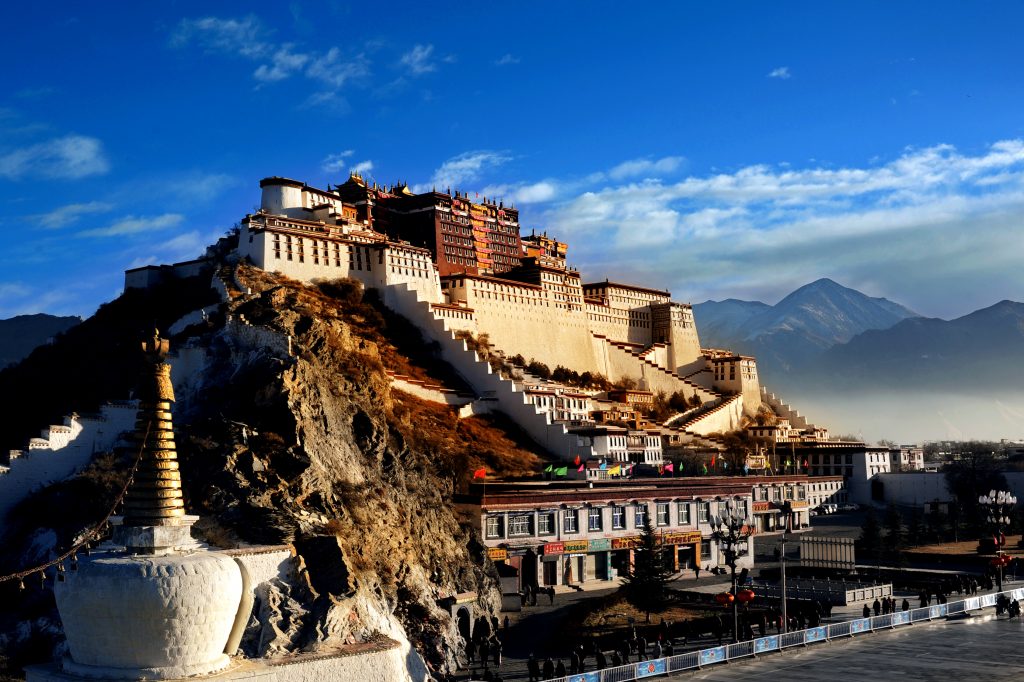Simikot Mt Kailash trek is a prime route linked to the far western remote region of Nepal. The trail follows a gradual climb up with a mix of cultural inhabitant areas. The route follows The Karnali River valley which is one of the beautiful nature trails to nomad caravan journeys. As this is located at a high altitude in a very remote area, it requires a special permit. Simikot Mt Kailash Trek provides an opportunity to experience both Nepalese and Tibetan Culture. A stone pillar that marks the Nepal/Tibet border is just across a rickety wooden bridge, perhaps one of the most informal border crossings in the world. The trail follows a gradual climb up with a mix of cultural inhabitant areas. In the lower elevation area you have lush green wish landscapes sceneries and an upper valley semi-Tibetan type of vegetation zone.


You can view the Saipal Himal 7031 meters from the left side of the plane as you approach Simikot; you may also be able to spot Rara Lake some distance off to the right. The Chinese border guards in the post on the ridge above the Humla Karnali will want to see your passport and Chinese visa. Hereafter you can make your trip to Mt. Kailash or to the old city of Lhasa. The attractions likely to be of interest to trekkers beyond Simikot lie in the rugged scenery & the scattered traditional villages with significant mountain range, Saipal Himal. Mount Kailash, located in the far west corner of Tibet, is the most sacred peak of Asia. The beauty of the 6700 meter high Mount Kailash, that looks like a symmetrical cone shaped rock capped by pure crystalline ice all the time, is echoed in various mythological and literary works.
Hindu pilgrims consider the mountain to be the home of their Lord Shiva.For Buddhists, Mount Kailash is said to be the Center of the Universe-the axis mundi in Asian cosmology. Every year hundreds of pilgrims travel from all over the Indian sub continent and Tibet to make the ritual circumambulation around the mountain in their quest for enlightenment and this trek will join them on their journey.
From Kathmandu, you will take a flight to the Nepalgunj. It is the town in the Western Terai and is very close to the Indian Border and the Bardia National Park. The town is a major transport hub for western, mid- western and far- western regions of Nepal.
On the following day, you will fly from Nepalgunj to Simikot. The trip is a thrill ride through the ridges and ravines in the spectacular mountains. The landing at the tiny mountain airstrip at Simikot is an unforgettable experience. It is no less adventure as it is just a graveled airstrip. You feel like you are in a different realm because of the sudden rise in altitude and sudden fall in temperature. To leave behind the scorching hot climate behind, to be in a tiny mountain village and to be breathing cool and fresh air gives you an adrenaline rush and refreshing feel. Simikot is situated on an airy spur above the Humla Karnali River and you should take time to explore the town and some of the surrounding villages to discover a way of life that has barely changed in hundreds of years.


You will commence your trek, climbing up from the airstrip on a rocky trail passing fields of barley and wheat. You will then ascend a forested ridge above the town of Simikot. From there it is a descent of about an hour to Mazgaon. You have to trek through the pine forest where you can see local Hindu and Buddhist people in their traditional attire accompanied by their herds of cattle. Once you pass Majgaon, the track gets uneven. On one corner it is descent whereas on the next corner it is ascent. This particular topography is called Nepali flat. It is green and lush than what you will see a little higher.
From Dhara Pokhari, the trail is a bit steep until you cross a long slope and follow the river to a waterfall near the shepherds’ camp at Chachera. You will then climb over a ridge and bypass the village of Kermi before entering a big valley with walled fields of potato and buckwheat. After walking through a sparse pine forest you will descend from the ridge to the Salli Khola and camp by the river.
Leaving Salli Khola, you will continue your trail to Muchu. Crossing the river, we then climb over a rocky ridge before descending to the grey waters of Humla, Karnali. Then you can see a goat herders camping by the river in a sandy meadow after crossing another ridge. The valley gradually narrows and we cross several more ridges, passing the villages of Yalbang and Yangar. The trail then winds its way precariously above the river before you cross a suspension bridge to the village of Muchu.


The first rest day will be at Muchu. You can simply relax on this day of walking around Muchu. This day is best for acclimatization too. We can explore the valley around Muchu and explore the village with its stone houses and Gompa.
After a day’s rest at Muchu, you will move forward and follow the trail over a ridge to the Tumkot Khola. Continuing your trial , you will walk along the rocky stream bed for a short distance before beginning a steep climb through a rock-filled gully. You will then pass through Palbang and its bright yellow mustard fields to the small settlement of Yari and beyond here the route climbs up the valley towards a pass, the Nara Lagna.
Today, you will have a very steep ascend to the top of Nara Lagna (4580 m). Then our trail descends. On the route, you can have the view of the Tibetan Plateau before arriving at the village of Ranipauwa. Walk carefully, since you may slip and slide on a surface of loose pebbles down to the Humla Karnali.
Leaving Hilsa, you will commence your trek to Taklakot. You have to cross the Nepal -Tibet border which is marked only by a stone pillar. This might be the most informal border crossing you might see throughout your lifetime. Taklakot is the largest trading center from where you will be driven to Mansarovar, the most venerated of Tibet’s many lakes. It is a rough fantastic drive that gives a taste of what lies ahead. It is an incredible drive past the snow capped peak of Gurla Mandata (7728m) as the road climbs higher onto the Tibetan Plateau.
In places the road is no more than the tracks of vehicles that have passed this way before. Today you will be sent to the highest lake of fresh water with turquoise complexion in the world. It is full of fishes and swans. Holy Kailash Parbat, Mt. Gurula-Mandala, Lake Rashekshi are lying on its surrounding. The region is considered rich for gold and other mines, hot springs and hundreds of wild living creatures. You pass through Tibetan villages where prayer flags flutter from the roofs of the whitewashed houses.
You will be spending a day in Mansarovar allowing your bodies to acclimatize to the altitude and exploring this fascinating place. We will visit the picturesque Chiu Monastery on the North West shore of the lake with the imposing sight of Mt Kailash in the background. The scenery is stunningly beautiful with panoramic views of the Himalayas.


After a day’s rest at Mansarovar, you will leave the lake and continue your journey to Tarboche. Tarboche is marked by a tall pole adorned with prayer flags. This is the starting point for your Kora, the 53km trek around the mountain and is the site for Tibet’s most important annual Saga Dawa festival. You will drive for about 35 kilometers towards Mt Kailash.
Leaving Tarboche, you will walk up to the Lha Chu Valley through beautiful green meadows and streams with Mt Kailash towering above us. It is one of the exciting days walking along the beautiful rocky cliffs; waterfalls with some clouds in the clear blue sky make you feel that Great God Shiva is everywhere with tons of blessings to you. Continuing up the valley, the north face of Kailash comes into view before we reach the 13th century monastery at Dira-puk.
Commencing trek from Dir-puk, you will now leave the Lha Chu Valley and enter the Drolma Chu Valley, heading up towards a high pass, the Drolma La [5630m]. It’s a tough climb to the summit which is festooned with prayer flags but from there it is all downhill or flat to Zutul-puk, with views of one of the highest lakes in the world, Thukpe Dzingbu Lake, known as the Lake of Compassion. As well as the monastery at Zutul-puk, there are several meditation caves and another cave containing an image of Milarepa.
Throughout the trail today, you are treated to magnificent views of Kailash. You will cross several streams, and follow an impressive gorge. You will then enter the Bharka plain and it’s about an hour’s walk through this desert-like landscape to Darchen.


The drive today is very long. You have to drive around 300 kilometers to reach Paryang. Along the way, you will cross the Mayun-la and make several river crossings. The scenery along this section is some of the most panoramic views of the entire journey.
Today’s drive is also very long but not so long as compared to the previous day. You will continue driving today along a 255 kilometers stretch of road to Saga, passing through the small, dusty town of Zhongba en route.
Today is the longest drive of your journey, 452km to Shigatse. Leaving Saga, you will pass the turn-off for the northern route and skirt around a lake, passing through a series of valleys. Approaching Kaga, you’ll come across the first trees and agricultural fields that you’ve seen for many days and the town itself is situated next to a picturesque lake. You will continue on to Lhatse where you will join the paved Friendship Highway and follow it for the final 150km to Shigatse, the second largest city in Tibet.
Wake up early this morning for a sightseeing tour in Shigatse. Today, you will visit the Tashilhunpo Monastery, one of the largest functioning monasteries in Tibet, before driving 90km to Gyantse. Once you reach Gyantse, you can explore the Pelkor Chode Monastery and the Gyantse Kumbum. The Kumbum is a large gold-domed stupa and its many chapels house an impressive array of Tibetan Buddhist murals.
Leaving Gyantse, we drove 261 kilometers towards Karo la (5045 m). You will be treated with an awesome sight of a huge glacier tumbling down to within a few hundred metres of the road. Beyond the small, developing town of Nagartse, the road follows the bank of a beautiful turquoise lake, the Yamdrok-tso, for about 20km. You will then cross the Khamba La (4794 m) and continue on to Lhasa, the capital of Tibet.


You will spend your following day by visiting several Lhasa’s monasteries in the company of a guide and interpreter. One of these is the Sera Monastery, which is one of the best preserved monasteries in Tibet. Within its white-washed walls and golden roofs, several hundred monks live and study. After lunch you’ll visit Norbulingka, the summer palace of the Dalai Lama, as well as the Jokhang Temple. This temple is possibly the most sacred shrine in Tibet and there is always a procession of devout Tibetans through the complex. Surrounding the Jokhang is the Barkor – a maze of narrow cobbled streets which is the central market of Lhasa.
This morning you will visit the Potala Palace which dominates the city of Lhasa. A spectacular building, it contains the private quarters of the Dalai Lama as well as numerous grand state rooms and many important chapels. There has been a palace on this site since the 5th or 6th century, but the present palace was constructed in the 17th century. A visit to the Drepung Monastery this afternoon will complete a truly awe-inspiring day. Founded in the 14th century, this monastery was once the largest in the world with a population of around 10,000 monks. These days that figure is down to several hundred, but there is still much of interest as it was left relatively unscathed during the Cultural Revolution.
The final day in Lhasa is a day at leisure in which you are free to explore further, revisit a favorite monastery or simply sit in a café overlooking the Barkor and watch the pilgrims as they circumambulate the Jokhang, stopping regularly to peruse the merchandise at the stalls lining the route. There is also the option of an additional tour to places such as the Tibetan Medical Centre, Ganden Monastery and Tsurphu Monastery, but this will incur extra costs.
On the last day of your journey, you will leave Lhasa early in the morning. Then you drive two hours to reach Gonggar Airport and take a flight from Lhasa – Kathmandu. You will fly right across the main Himalayan range and the mountain which will have the spectacular views.
Shopping is my option in contrast to Red Bull. Regardless…


Hundreds of years of preservation and perseverance, nourished and timely…
Among the many 12 years festivals Nepal has, Lha Phewa…